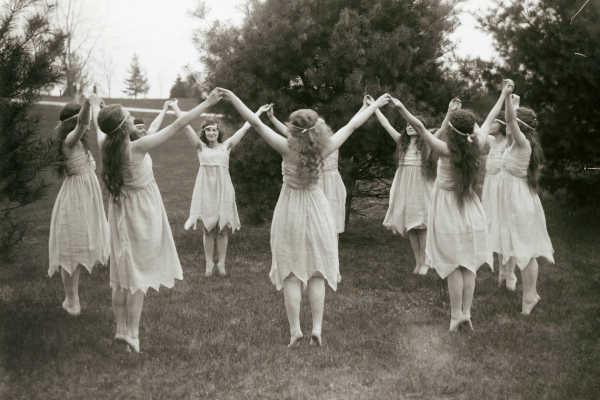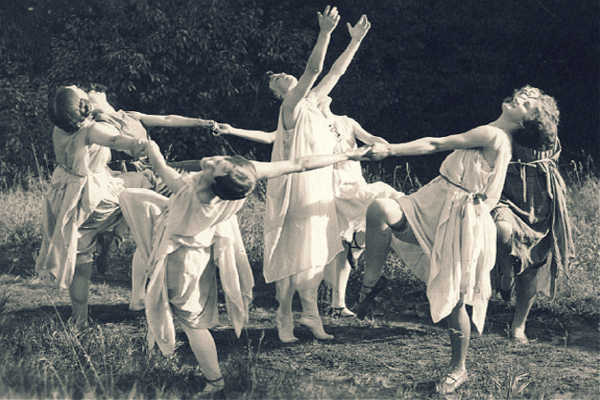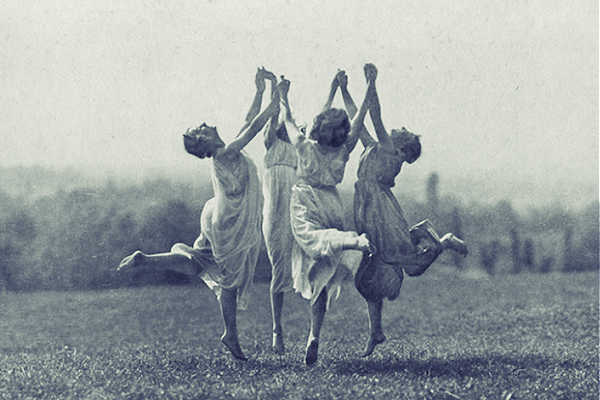In the pursuit of personal growth, it is easy to overlook the power of creating a strong inner circle. The sacred circle of unity plays a crucial role in supporting your journey. Let’s explore the sacred meaning of circles and circle rituals for transformation.
Many ancient cultures recognize the synergy of the circle and its inherent power. Nature uses circles or spheres to build and organize. It’s also a standard behavior of energy. Drop an object into water, and you will see how the energy projects outward in equal concentric rings.
In nature, the circle is the preferred structure. We see them from the cells in our bodies to trees. This spherical shape is stable and sturdy. We observe the world through eyes with a circular iris.
The Power Dynamics in An Inner Circle
What exactly is an inner circle? These are the people who understand and support our goals, dreams, and values. These are the ones we turn to for advice. They provide encouragement and accountability.
Creating a strong inner circle has a significant impact on our mindset. Our mindset determines our behavior. So, those in our inner circle help us when we doubt ourselves. They challenge us to become the best version of ourselves. This group is our sacred circle of unity and power.
Why is it essential to have such a circle in our lives? Well, as the saying goes, “You are the average of the five people you spend the most time with.” This core group influences our thinking and important decisions. They have access to speak the truth, and they help us gain new perspectives. As a network of support and accountability, they are indispensable. When we share our dreams with others, we increase our likelihood of success. We create an environment for growth, learning, and fulfillment.
In the realm of personal development, we often focus solely on individual transformation. However, it is equally essential to explore the dynamics within our inner circle. They can have a significant impact on our spiritual journey. Our interactions with the people closest to us can either elevate or hinder our growth. Understanding the power dynamics in an inner circle will help you get the most out of them.
1. The Hidden Power Structuring Our Inner Circle. In every inner circle, there exists an implicit power structure. The power structure governs how decisions are made. It influences the opinions of those in the group. Understanding this hidden structure is crucial to determine how it affects our lives. Are we the enablers, the trusted advisors, or the visionary leaders within our circle? Identifying our role in the hierarchy helps us to deal with these influences.
2. The Impact of Like-minded Souls. Surrounding ourselves with like-minded individuals is often considered vital for spiritual growth. However, it is equally important to evaluate the dynamics within this homogenous group. Are there certain individuals who wield more influence or possess more knowledge? By acknowledging any imbalances, we can overcome any roadblocks. Exploring conflicting opinions cultivates a more inclusive environment. It encourages others to speak up, which makes the group stronger and more cohesive.
3. Nurturing Challenging Relationships. Within our inner circle, we may also encounter those who challenge our thinking. These relationships can be uncomfortable at times. However, they can serve as catalysts for profound personal growth. Understanding the power dynamics of these interactions helps us learn valuable lessons. We evolve from such encounters without being invalidated.
4. The Power of Emotional Support in Spiritual Growth. Supportive relationships play a critical role in our spiritual development. Our inner circle should consist of people who uplift, encourage, and inspire us to grow. These relationships allow a safe space for vulnerability. And they should encourage emotional nurturing, augmenting our journey toward enlightenment.
5. Honoring Boundaries and Consent. Consent and boundaries are paramount, even within our closest circles. Recognize when boundaries are being crossed. Learn to discern when we overstep someone else’s boundaries. This self-awareness is essential for creating a healthy power dynamic. Set an example by cultivating respect for the ideas and opinions of others. We each have the power to create a place conducive to growth for everyone involved.
Summing up Power Dynamics. It’s time we shift our focus from viewing our spirituality as a separate endeavor. We must grasp the realization that we are interconnected with those in the circle. To create a healthy circle, we must address power imbalances, nurture each other, and honor boundaries.
Remember, the power dynamics within your inner circle can aid or hinder your journey. Choose wisely and navigate thoughtfully. The true power lies in developing growth and harmony within ourselves and those closest to us. Now, it’s time to take a closer look at the symbolism of the circle.
The Everlasting Symbolism of Circles
“Archetypes are universal, and, in subtle or extravagant ways, interchangeable.” — Tanith Lee
There are six primary universal shapes from which most other archetypes are made. The six universal shapes are a dot, a straight line, a triangle, a cross, an S shape, and a circle. The latter represents totality, wholeness, and the demonstration of perfection. So, the circular shape is often used with other shapes to create unique meanings. (1)
“All the most powerful ideas in history go back to archetypes.” — Carl Jung
A circle suggests a sphere, which is a three-dimensional symbol of time and space. It is a symbol of celestial unity. The circle is a shape that is echoed in the heavens with our closest lunar partner, the moon. The idea is found in texts like the Hermes Trismegistus. The text says, “God is a circle with no center or edge.”
“The Pearl of Great Price” is a typology of a circle found in the New Testament, Matthew 13:46. It shows the extent to which this symbolism permeates the culture. A winged circle represents the primordial cosmic pair. Twin circles represent the male and female genders. The Dioscuri, or triple circle, represents the triad. Here is where the dying god sects got the three persons of the Trinity, and four circles form an x, the Celtic cross. The seven-fold circle symbolizes the “all-knower.”
“Concern for the symbol has completely disappeared from our science. And yet, if one were to give oneself the trouble, one could easily find, in certain parts at least of contemporary mathematics… symbols as clear, as beautiful, and as full of spiritual meaning as that of the circle and mediation. From modern thought to ancient wisdom, the path would be short and direct if one cared to take it.” — Simone Weil
Many cultures use this shape as a vital part of circle rituals for transformation. Shamanic practices still use fire as a central point. Everyone gathers around the fire in a circle. Reiki uses them in many of their hand motions and sigils. Circular motion is a classic method in Tai Chi and Tai Ka to collect and direct energy.
Witchcraft and Wicca use the synergy of the circle. The classic form is gathering around a fire. Its value as a focal point and mechanism to generate power is fundamental to these arts. It doesn’t have to be perfectly round. You can draw a circle in the air with your hand. This shape and its cousin, the spiral, are common elements of Eastern healing and martial arts. You can create a sacred magical space anywhere.
Western organized religions use the symbol of the circle extensively. It represents the halo, a sign of divinity. It is represented in the crown of thorns. This is one of the ancient interrogation devices used in many cultures. (2) It was a way of mocking, torturing, interrogating, pushing in, or twisting to cause more pain.
Three intertwined circles form the Triquetra. This is an ancient Celtic symbol of unity, used to represent the Trinity. The most common representation is the use of a ring to symbolize a bond of commitment. It’s used in many marriage ceremonies, not just within Western religions.
The Sacred Meaning of Circles
Something sacred is that which is dedicated to or associated with the divine. The circle represents the unending divine cycle of life.
The circle is a simple but eloquent symmetric geometric shape with a central axis from which the distance to the center is equal. The curve of the line around this axis maintains the same arc. It is a shape challenging to draw freehand. Most people can see this flaw if this arc is off by 1%. Perhaps this is one reason for the everlasting symbolism of circles.
A magical space is a vortex of energy traveling outward. When we contain this energy within any enclosure, it reverberates. Over time, it will dissipate unless the energy source produces more. People are both the generators and containers of the power dynamics in an inner circle. Gathering together in a circular pattern is a way to generate and direct the vibration.
An excellent example of the practical and synergistic effect of the use of this shape is the fire circle. Here, people used fire, light, and drums to create community. It provides the ability to connect with many people in a small space. It is also a common shape for ancient camps and caravans because it provides practical protection. The sacred circle of unity leverages the practical, the scientific, and the spiritual.
“The ‘squaring of the circle’ is one of the many archetypal motifs which form the basic patterns of our dreams and fantasies. But it is distinguished by the fact that it is one of the most important of them from the functional point of view. Indeed, it could even be called the archetype of wholeness.” — Carl Jung
Many places incorporate the symmetry and sacred meaning of circles into their design. The arch is a symbolic doorway that links to a sacred magical space or portal. Many structures like temples and churches have arched ceilings. Arches are self-supporting forms that echo the shape of a circle. Many churches decorate these vaulted spaces to draw our attention.
Circle Rituals for Transformation
Rituals that leverage the unity of people in a circle can be life-changing. They provide a safe space, allowing us to release old wounds, patterns, and beliefs that no longer serve us. By joining with the collective energy of the group, we create space for new possibilities. This energy is magnified when we perform ceremonies together. It may be writing down negative self-talk and burning it. Or perhaps through cultivating the energy via guided visualization or Tai Chi. These rituals provide a container for our transformational journey.
The construction of a physical sacred circle of unity is a process guided by the everlasting symbolism of circles. The circle itself represents wholeness and unity. It serves as a container where participants feel safe within the space. This safety provides an opportunity for vulnerability and trust.
Four cardinal points are typically marked to represent the elements of earth, air, fire, and water. This lends a sense of balance and harmony to any ceremonies conducted. Every element contributes to the intricate dance between the participants and the energy they invoke. Participating in a powerful sacred circle working can be exhilarating and life-changing.
To fully appreciate rituals that are based on the synergy of the circle, we must delve into their origins. Many ancient civilizations used sacred circles. Native Americans and Celtic cultures used circles in art, architecture, and ceremony. Gathering in a circle was a part of the culture that created a safe space for spiritual connection and celebration. These circles were designed to mimic the cosmic cycles. They had detailed symbolism that demonstrated their vast knowledge of the cosmos. They used rituals to harness communal energy, amplify intentions, and honor the sacredness of life.
The Greeks saw the circle as a symbol of divine symmetry and balance in nature. However, the Greeks refer to the Egyptians as the inventors of geometry. The author of the Egyptian Rhind papyrus, Ahmes, shows us the rule for determining the area of a circle. The wheel is a practical application of this shape.
They say hermetics (3) is the birthplace of real alchemy and magic. It’s an esoteric tradition (4) based upon writings attributed to Hermes Trismegistus (“Thrice Great”) (5). It talks about spheres as planets and how they have their unique characteristics.
The Kybalion is a classic work of Hermetic Philosophy, originally published in 1908 under a pseudonym. It explains the concept of motion as a process that manifests in everything in the Universe. Nothing rests, and everything moves in a circular or spiral fashion.
One thing that all cultures have in common is their affinity for using this shape. It holds inherent power because of its uniform shape. It is a powerful symbol and typology today. As a sphere or round object, they often represent harmony and unity. It is a versatile shape. Each culture adopts and adapts this shape for its own needs.
The synergy of the circle is the secret to the operation of magic. Creating this kind of space is fundamental to harnessing energy. You can do this by marking the ground. Attach a string to a stick in the center and walk around, tracing the circumference. The area within becomes your sacred magical space for everything from healing to protection spells. You can also create circles within circles for more advanced processes.
Creating a Strong Inner Circle
Personal rituals have power. The symbols we use help generate and focus our intent and willpower. Reiki is an excellent example of how symbols let us focus our energy. Reiki is a relatively new alternative healing art created by Mikao Usui (6) from Japan in the 1920s, using hand gestures to focus their intent. Many of these contain circular motions.
You don’t have to create a whole new healing arts system. However, you can develop your symbols to create meaningful rites or rituals. These rituals are a way of commemorating, honoring, or celebrating a milestone.
Creating symbols is more effective than copying someone else’s ritual or pattern. It’s easy to develop ceremonies incorporating the synergy of the circle. It will become a powerful tool in your practice. You can use it to create your own sacred magical space.
The Importance of Setting Intentions in Sacred Circles
Setting the intention is an essential part of any sacred circle gathering. Intentions serve as our guiding compass, helping us focus our energy and attention on specific outcomes.
When we set intentions, they become amplified by the collective energy of the group. Thus creating a strong inner circle. This force aids in the manifestation of our desired transformations. By being mindful of our intentions, we can consciously direct our energy towards personal growth and positive change.
1. Define your values and goals. Before joining a group, it’s vital to assess yourself. Define and understand your values and the goals you aim to pursue. This will help you attract people who align with your vision and have shared interests.
2. Seek diversity. While it’s important to find individuals who share similar values, it’s equally crucial to build a diverse inner circle. Surround yourself with people from different backgrounds, with varied perspectives and expertise. Their different perspectives will open your mind to new possibilities. New ideas always inspire innovative solutions to problems.
3. Engage in community activities. Attend local events, seminars, and workshops. Find things that resonate with your interests and passions. This will allow you to connect with people who are passionate about similar things. You’ll find those who share common goals, and they will enrich your journey.
4. Nurture existing relationships. Building a strong inner circle doesn’t always mean bringing in new people. Take the time to strengthen the relationships you already have. Make an effort to connect with people on a deeper level by engaging in meaningful conversations.
5. Be a supportive member. Remember, building a strong inner circle is a two-way street. To receive support and upliftment from others, you must also offer the same to them. Be an active listener, provide constructive feedback, and celebrate their successes. As a valuable member of the circle, you contribute to the growth of others and inspire them to do the same.
Creating a strong inner circle depends upon finding the right people. Setting intentions in sacred circles gives the group a collective focus. Valuing people and the planet helps to engineer a healthy environment.
The Sacred Circle of Unity
When people come together for a common purpose, it creates something greater than the sum of the people. If you have ever been in a group like this, then you know its power.
This collective synergy is what people use to create movements. If the purpose is for equality, freedom, and peace, then the results are positive. If the purpose is for destruction, like a military unit, then the results are always negative. When misused by religious and political extremists, the results are always disastrous.
So, we need to learn how to use the synergy of the circle for good and not evil. We need to learn how to leverage the power dynamics in an inner circle to improve society. Circle rituals for transformation are the tools that can create this positive change.
References
(1) An Illustrated Encyclopaedia of Traditional Symbols, J.C. Cooper, 1987.
(2) Myths & Legends, Babylonia and Assyria, Lewis Spence, 1916.
(3) Hermetic knowledge or Hermetic Writings. Britannica
(4) Western Esotericism. Wikipedia
(5) Hermes Trismegistus. Wikipedia
(6) Mikao Usui and Reiki. Wikipedia


